Corinna Bechko is co-writer of many Boom! Studios Planet of the Apes titles. But you knew that. What you probably didn’t know is that she also has a background in zoology and has been a researcher of orangutans and chimps. Really! So she took the time to interview three primatologists about their appreciation of — and apprehension regarding — the Apes films.
By CORINNA SARA BECHKO
The original “Planet of the Apes” film burst onto the silver screen in 1968 and immediately became a cultural touchstone. Somehow, by skewing the world just enough so that apes held power instead of people, it gave us a way to talk about a lot of issues in a new way. Racism, the power that comes from controlling the truth, science, religion, the expediency of violence, the threat of nuclear war, feminism, classism, all took their turn in one or another Apes film. Oddly, just about the only thing that doesn’t come up when discussing Planet of the Apes is actual apes. That is, unless you work with them yourself.
I spent five years as a research assistant at the L.A. Zoo, working on projects that investigated the best ways to provide enrichment to the lives of captive orangutans and chimpanzees. When I got the chance to co-write comics for Boom! Studios set in the world of the original films, I drew a lot on what I learned at the zoo, but found that it applied more to the mute humans than to the other primates. And so I wondered, what did ape keepers — Brenda, Angela and Mike — with their intimate knowledge of real apes, take away from the films? Here’s what three of them have to say:
When did you first become aware of Planet of the Apes?
Brenda: I was only vaguely aware of the original movies when I was a kid. But on a Thanksgiving weekend in the late 1980s, one of the cable stations was doing a POTA marathon, and I watched them all. (Many years later I hosted a Planet of the Apes viewing party at my apartment in L.A. for my zoo friends and coworkers…)
Angela: In 1968. It was amazing!
Mike: I believe I saw the original 1968 original movie with Charlton Heston in the early ’80s. I think like many people I judge the new movies to the original classic. The 2001 Tim Burton remake I was not a big fan of. The makeup/costumes were OK, but I did not like Mark Wahlberg in the lead role. Just do not think he did good acting in that role. This is only my opinion. No offense to Mr. Wahlberg.
Which film is your Apes favorite?
Brenda: Some of the exteriors for “Escape” were filmed at the L.A. Zoo, where I’ve worked for more than 10 years, so that movie has a special place in my heart, though I wouldn’t say it’s the best of the franchise. In terms of storytelling, the original 1968 is probably the most impactful, plus you get to see more of the apes’ culture and society. I really love all the early movies, despite the primitive ape masks and makeup and often campy dialogue.
Angela: “Beneath the Planet of the Apes.”
Mike: My favorite has to be the 2011 “Rise of the Planet of the Apes” movie. The CGI of the chimps was awesome and getting Andy Serkis to play the part of Caesar I believe was a big key to making that CGI character so great. He did a great job of capturing the movements, vocalizations, and behaviors of the chimpanzee(s) and brought the role of Caesar the chimp to life. I also liked the plot, the acting cast as a whole, and how it explained everything leading up to the original. Although the movie is considered science fiction, I think the 2011 movie was the most believable to me, as well.
We are living in a technological age where we are actively searching for a way to prolong our lives. Having worked with many retired, government-owned chimpanzees at two different retired-chimpanzee sanctuaries (and knowing some of the behavioral and biomedical research performed on these chimps in the past to better enhance our lives as humans), I didn’t see that movie as that far-fetched from what could be reality.
I have witnessed infant great apes born and raised in captivity used only for the sole purpose to entertainment us as humans. They are given a certain amount of freedom at a young age and then when they reach maturity they can overpower us or go against us when we want them to perform ‘tricks’ for us, so we put them behind bars? It’s not right and very sad to me. One thing I like about the “Planet of the Apes” movies is that the roles are reversed and the humans are kept as pets or slaves, and that makes us as humans watching think about how we’ve treated captive chimpanzees.
What do you think the films get right and wrong about ape behavior? Do you think the new film is an improvement over the older films in terms of how the apes are portrayed?
Brenda: The most glaring “wrong” in the early films was the decision to make gorillas the warriors, while chimpanzees are pacifists. Gorillas have always had a fearsome reputation in popular culture, but anyone who has worked with or studied them knows they are actually quite peaceable. A silverback will chest-beat and charge when threatened, but most of the time, it’s all bluff. Chimps are indisputably more aggressive (but they’re still my favorite!). They are also very intelligent, and if I had to bet on which ape species would be most likely to one day rise and take over the planet, it would be them.
“Rise of the Planet of the Apes” was a huge improvement in terms of how the apes are portrayed. The computer-generated imagery is fantastic, and it’s obvious the actors who portrayed the apes studied the movements and mannerisms of real apes. The ape sanctuary also looks like a real primate facility, albeit a terrible one. The caging, transfer tunnels, etc., were true to life, but the big dayroom where all the chimps (and an orangutan) hang out together was a stretch.
Angela: I’m so forgiving of the “wrongs” because I just love the concept and fantastical nature of the series … you know, like the speaking and the bipedalism … I love that aspect.
Considering the fact that in-depth, behavioral studies of apes was relatively new in the ‘60s, the early films were quite accurate in their depiction of non-human primate factions — the militaristic Gorillas, the diplomatic Orangutans, the nervous, chatty Chimps — allotting these groups a “standardized” behavioral model, worked well in the earlier films. The generalization of these groups was fine for the story being told, at that time.
Group and individual behavior was really brought to the forefront in the new film “Rise of the Planet of the Apes.”
I thought the calculated plotting of attacks and the aggression with the lab assistants, malicious caregiver and with each other, was all very indicative of captive behavior.
The mercy shown for the assistant caregiver, was pretty interesting. … I’ve seen quite a few unmerciful acts happen before my eyes. Some chimps will find your weakness and exploit it.
I especially liked their inclusion of the physical effects of aberrant behavior in captive apes … the bald patches and mohawks (due to self-mutilation and hair pulling) … all those telltale signs of stress, lack of enrichment and lack of freedom. These are aspects of captivity that people rarely hear about or see.
I would’ve liked to have seen some of the captive chimps exhibiting episodes of psychotic frustration (rocking, screaming) … but, I think the filmmakers took it to the next level and gave the public a nice glimpse of the horrors of captive-ape existence.
(I never made it through the Tim Burton version.)
Mike: I have only seen the 1968, 2001, and 2011 films. From what I’ve seen of the films I think they portray many aspects of ape behavior correctly even though these are science fiction movies. The anatomy of the chimpanzee brain and central nervous system is startlingly similar to our own. It should not be surprising, then, that chimpanzees (along with gorillas and bonobos) are capable of intellectual performances once thought unique to humans.
The social life of an ape is based on a hierarchy system. It is good to be king, aka, alpha male, however it does not come without its struggles and battles. The 2011 film I find much more realistic to how chimpanzees are portrayed by humans than the ’60s/’70s films and better portrays the species, I feel. Andy Serkis and the CGI computer animation better mimicked the natural movements of the chimpanzee than any actor in an ape suit prior.
The biggest negative that comes to my mind when it comes to the movies is this famous phrase “Get your stinking paws off me, you damned dirty ape.” Such a famous phrase like that puts such a negative spin on the species. Paws? No they have opposable thumbs and fingerprints just like us!
I hope that when the public watches the films they do not think that primate care-givers carry around shock sticks and whatnot punishing chimpanzees! The people I have worked with that care for primates want nothing but the best for animals in general. In this day and age every facility, zoo, or sanctuary should have an established enrichment program, and if they don’t, they should be under public scrutiny.
I feel the movies portray the good and bad of us as human beings. I feel the public has a bit better understanding of the lives of chimpanzees with such documentaries as Disney’s “Chimpanzee” and through the knowledge and teachings of such great ambassadors to the species like Dr. Jane Goodall. But as a whole, there is still a lack of knowledge the public has about the natural lives of chimps and the lives of chimps in captivity.
What’s the most memorable thing an ape you’ve worked with has done?
Brenda: One day I was hanging out near one of the chimps … named Booie, a real sweetheart. He took a thick piece of hair from his forearm and poked it through the fence. I reached up and took it, said thank you, and set it on the ground next to me. That seemed to bother him. He gestured, vocalizing, then gave me another one of his forearm hairs. Again I took it and thanked him, but I stuck this one it in my pocket to show that I would keep it. For several years I had that chimp hair taped on my computer monitor. How nice to get a “gift” from a chimpanzee!
Mike: I have bonded with many of the primates I have worked with in the past years through grooming. And vise versa. It is a powerful thing to have enough trust in an ape to let him or her pick at the hairs on your forearms knowing that if they wanted to at any second they could severely injure you if they had the motive to do so. The one thing about chimps I have learned is that they are the only species I have known besides humans to be deceiving. Many only look upon us humans as competition.
I have known chimps to show signs of affection just to draw you in closer and do you harm. Once you get close enough to them they can spit at you or throw feces at you with great precision. You are lucky if this is the worst that happens to you. If they grab a hold of you … you’re in trouble. I have worked with some chimpanzee animal keepers missing a finger from a chimpanzee bite.
I think the most memorable of all the ape encounters I have had was when I helped to raise a baby Borneo orangutan named Rocky. He was the first and possibly the last diaper I will ever have to change! Just like a human infant he had his binkies and his blankets and a crib. To look into the eyes of a 1-month-old baby orangutan and to have him stare straight back into yours. You can tell the wheels are turning in his brain trying to figure out who you are to him. And me as a human, I was thinking, “Maybe he will think of me as a sort of father figure,” and at that moment he smiled at me, stuck out his tongue and grabbed my nose with his little soft opposable fingers and thumb. I think this might have been Rocky’s telling me in his own sweet little way that I have my downfalls of being a human being.
Angela: In addition to plotting attacks and antagonizing each other, chimps can also be compassionate and empathetic.
A female chimp hurt herself and needed to be separated from her group so she could convalesce without incident. She was separated from her group for about 2 days and I felt she needed some company, so I moved a sweet, gentle male from her group into her enclosure so she wouldn’t feel so isolated. She was too weak to move and eat on her own, so I had been hand-feeding her. When I moved the male into the enclosure with her, he went directly for the chimp chow, filled his mouth with the biscuits, sipped water and let the biscuits soak in his mouth. I assumed he was just happy to be away from the other male and have the food all to himself. He promptly perched himself next to the female and just sat there — his cheeks bulging with chimp chow and water. I gave the female her medication and some fruit juice. The male then took the gummy, soaked-biscuits from his mouth and put the mixture into the female’s hands, for her to eat. He then went back to the pile of chimp biscuits and filled his mouth up, for himself.
It was beautiful.
Is there anything else you’d like to share about working with apes and how it intersects with the popular idea of apes that many people have from films?
Brenda: The way apes are often used in film, TV, and commercials has led to many misconceptions, not only about their behavior but also their conservation status. Chimps are usually portrayed as cute, cuddly clowns, placed in human situations for comedic effect. Dressing chimps in clothing and prompting them to mimic human behavior may generate some laughs, but it distorts public perception and prompts many people to think they make good pets (they don’t!). And their widespread use in the entertainment world belies the fact that they are an endangered species. Seeing chimps in sitcoms and commercials, people don’t believe they are in serious trouble in the wild.
Mike: Again, I just want to stress how much of the public only knows chimpanzees through the human media such as the old Tarzan TV shows, or through TV commercials, when these chimps are juveniles being dressed up in human outfits making them look like clowns and a joke only to hit maturity and be locked away after we are done as humans being amused by them.
As a society I am glad we are changing the wrongs we have done to these magnificent primates in the past. These are incredibly intelligent creatures sharing 98.6% of our DNA makeup. They are more human than monkey and people call them monkeys, which is off. They are great puzzle solvers and the “Planet of the Apes” movies do portray this fact, (although they are scientifically enhanced in the movies as a species). In actuality there are particularly close parallels between chimpanzee infants and human children.
They are not meant to be our pets. They do not belong in captivity. And they will let you know that they do not belong in captivity when you work with them. We owe them a great bit of respect and appreciation for our understanding of modern human medicine and disease control.
—
MEET THE CAREGIVERS
Brenda Scott Royce: A former book editor and chimpanzee caregiver, Brenda is currently director of publications for the Greater Los Angeles Zoo Association and editor of the zoo’s award-winning magazine, Zoo View. Her novels, “Monkey Love” and “Monkey Star” chronicle the misadventures of Holly Heckerling, a stand-up comedienne who befriends a monkey while trying to juggle career and romantic entanglements.
Angela Adams: Chimpanzee Supervisor/Head Caregiver at a sanctuary that housed 50+ chimps. Served as an Electrician’s Mate in the U.S. Coast Guard. Creator/animator of the web series “Geez Louise.”
Michael Christie: Mike worked as an enrichment technician at Chimp Haven with chimpanzees who had retired from medical research and the entertainment industry. He has worked with many other species as well at the Playboy Mansion zoo and at Wildlife Waystation. He is currently president of Sounds Güd Entertainment.
Corinna‘s Silliest Moments in Apes lore can be found here. Wanna buy her books? You should, here. Or hit any good online bookseller — or your favorite comic shop!

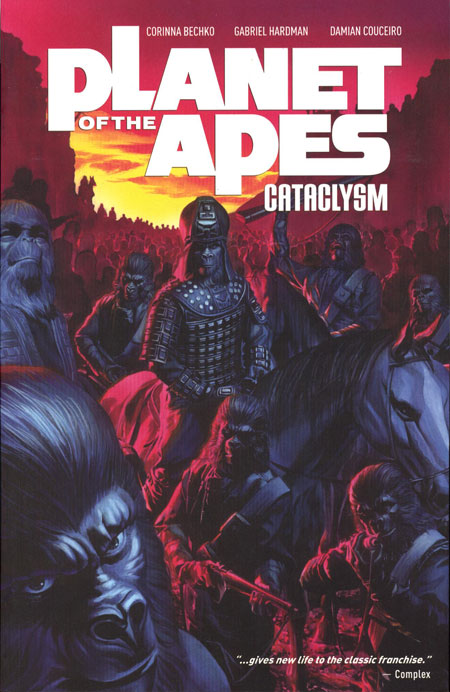
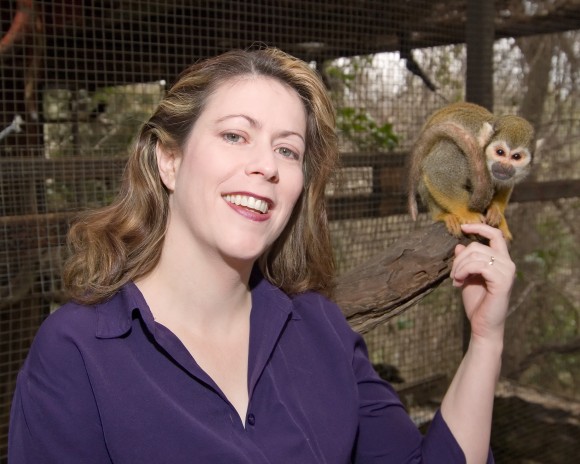
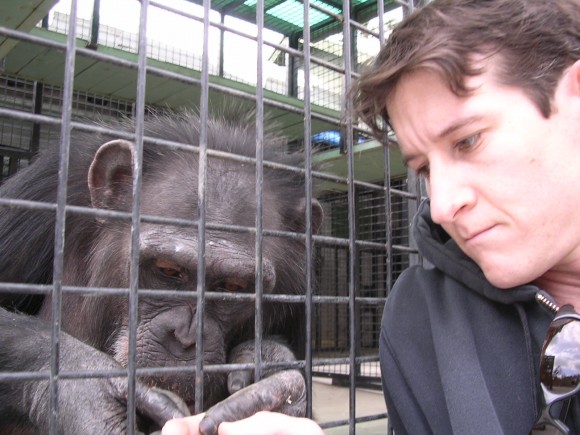
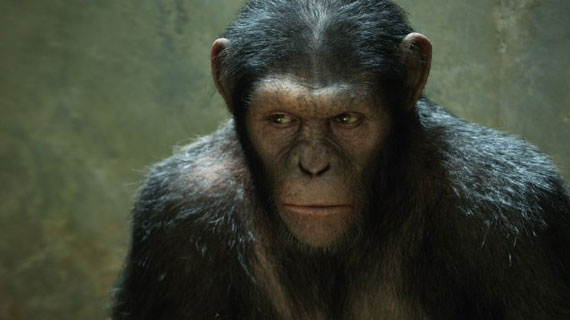
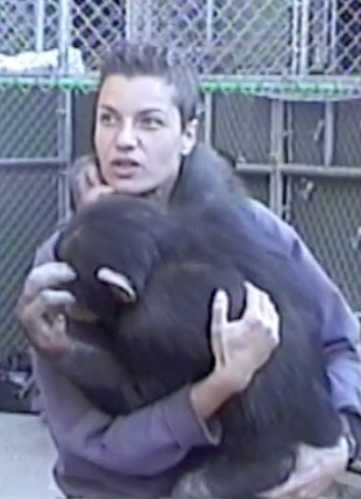
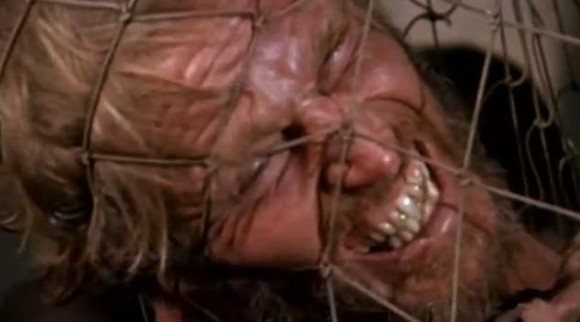
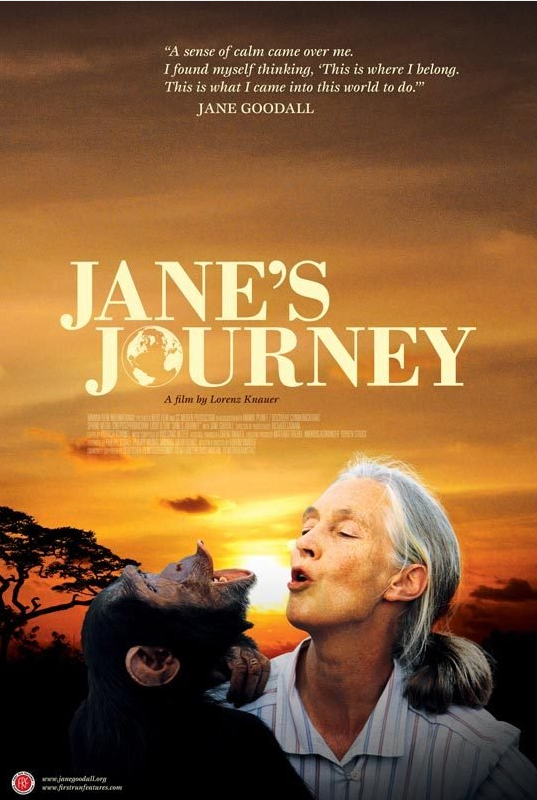
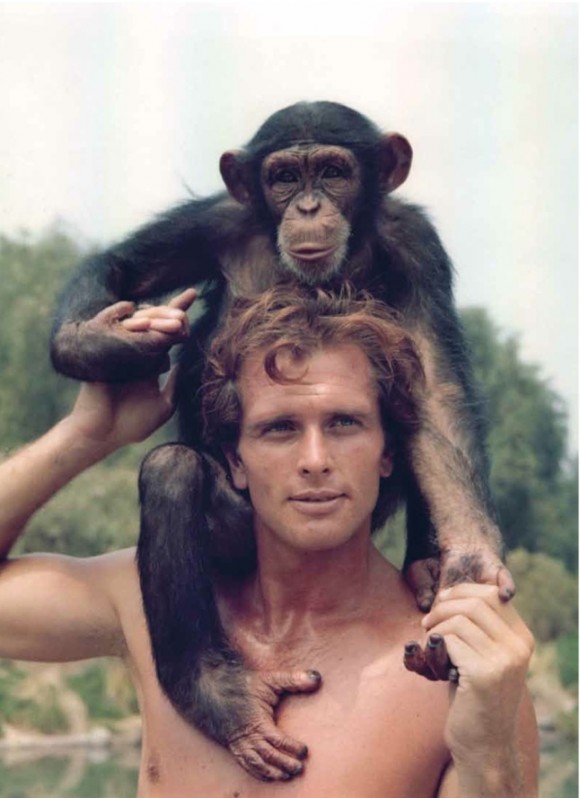
December 14, 2013
Enjoyed this very much. Very interesting reading, especially the personal accounts.
December 14, 2013
Thanks, P.J.! Corinna did a wonderful job on it!